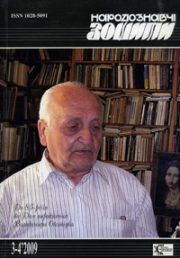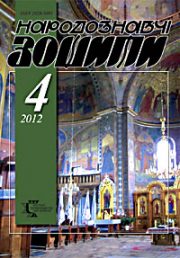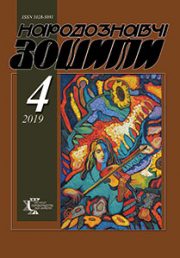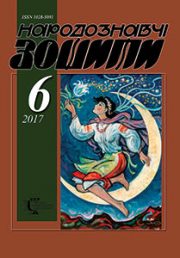The Ethnology Notebooks. 2022. № 4 (166), 971—986
UDK 75/79.072.2(477)”19/20″Г.Дем’ян
DOI https://doi.org/10.15407/nz2022.04.971
HRYHORII DEMIAN’S ART CRITICISM PALETTE
SOKIL Vasyl
- ORCID ID: http://orcid.org/0000-0003-3164-1217
- Doctor of Philology, Professor, Head of Department
- The Ethnology Institute of the National Academy of Sciences of Ukraine,
- Department of Folklore,
- 15, Svobody Avenue, 79000, Lviv, Ukraine,
- Contacts: e-mail: vasylsokil@gmail.com
KOVAL Halyna
- ORCID ID: http://orcid.org/0000-0002-2998-2357
- Doctor of Philology, Senior Researcher
- The Ethnology Institute of the National Academy of Sciences of Ukraine,
- Department of Folklore,
- 15, Svobody Avenue, 79000, Lviv, Ukraine,
- Contacts: e-mail: galyna.kov@gmail.com
Abstract. One of the important parts of Demian’s research work was art criticism, which has been his major for a long time. He was one of the first in Ukraine who had to teach an elective course of art criticism in school, as well as study the creative heritage of many artists, composers, singers and actors professionally.
The purpose of this article is to present the art criticism specialization of H.Demian comprehensively, to highlight his writings on maestros of brush and stage, as well as to emphasize his personal contacts with many creative people and his promotion of these figures among students and other admirers of Ukrainian culture.
The object of the study was a large cohort of artists, in particular, K.Ustyianovych, A.Novakivskyi, H.Smolskyi, A.Ni menko, P.Obal, O.Obrotsa, M.Ivasiuk, and M.Isopenko. Their works were associated with both Boikivshchyna and Bukovyna regions. The researcher paid considerable attention to the creativity of composers (O.Nyzhankivskyi, F.Kolessa, D.Sichynskyi, M.Lysenko, S.Krushelnytska, M.Skoryk) and singers (O.Nosalevych, I.`Slaviak, Z.Dachynskyi, Y.Stadnyk). The article summarizes extensive information about the life and art criticism heritage of these figures, who played a special role in the enrichment of the national identity of the Ukrainian people. The research uses different methods, namely biographical, statistical, culturological, and aesthetic ones.
Keywords: art criticism palette, artists, composers, singers, actors.
Received 30.06.2022
REFERENCES
- Dem’yan, H. (1968). My foothills are green. October, 7, 102—103 [in Ukrainian].
- Dem’yan, H. (1989, 14 September). K. Ustiyanovych and T. Shevchenko. Soviet Verkhovyna. Skole [in Ukrainian].
- Dem’yan, H. (1989, 4 November). In the footsteps of Kornil Ustiyanovich. Zorya (Yavoriv, Lviv region) [in Ukrainian].
- Dem’yan, H. (1990, 6 march). Bukovina with the glory of Taras. Soviet Bukovina. Chernivtsi [in Ukrainian].
- Dem’yan, H. (1995). Golden noise. Waves of Stryi (P. 283). Stryi [in Ukrainian].
- Dem’yan, H. Where K.M. Ustiyanovich died and was buried. In Viddil rukopysiv L’vivs’koyi natsional’noyi naukovoyi biblioteky imeni V. Stefanyka. F. 207. Od. zb. 94 [in Ukrainian].
- Dem’yan, H. (1972, 25 April). Creator of beauty. Soviet Verkhovyna. Skole [in Ukrainian].
- Dem’yan, H. (1972, 28 November). Slavic graphics collection. Soviet Verkhovyna. Skole [in Ukrainian].
- Dem’yan, H. (1983, 15 October). Inspired singer of the Carpathians. Skolivshchyna in the works of G. Smolsky. Soviet Verkhovyna. Skole [in Ukrainian].
- Dem’yan, H. (1978, 6 May). Rural exhibition of bookplates. Victory flag. Zastavna [in Ukrainian].
- Dem’yan, H. (1985, 9 July). The exposition includes bookplates. Victory flag. Zastavna [in Ukrainian].
- Dem’yan, H. (1990). Graphics of the Ukrainian artist from Poland Tyrs Wengrynovych in the exposition — bookplates. Folk Art and Ethnography, 5, 16—21 [in Ukrainian].
- Dem’yan, H. (1990). Tyrs Wengrynovych. Talents of Boykivshchyna (Pp. 53—54) [in Ukrainian].
- Dem’yan, H. (1993). Artists of Lviv Region: Calendar of anniversaries and anniversaries for 1994 (Pp. 53—54). Lviv [in Ukrainian].
- Dem’yan, H. (1995). Ukrainian schedule from Poland. Fights, 1—3, 45—46 [in Ukrainian].
- Dem’yan, H. (1965, 22 September). Generous talent. Builder of communism. Stryi [in Ukrainian].
- Nimenko, A. (1965, 2 November). Watercolors of spruce grove. Literary Ukraine [in Ukrainian].
- Dem’yan, H. (1965, 11 December). Generous palette. Builder of communism. Stryi [in Ukrainian].
- Letter from P. Obal to G. Dem’yan dated December 15, 1965. In Home arkhiv. Obal Petro folder [in Ukrainian].
- Dem’yan, H. (1966, 25 march). Exhibition of the Stryi artist. Builder of communism. Stryi [in Ukrainian].
- (1968). Letter from P. Obal to G. Dem’yan. In Viddil rukopysiv L’vivs’koyi natsional’noyi naukovoyi biblioteky imeni V. Stefanyka. F. 207. Od. zb. 202 [in Ukrainian].
- Dem’yan, H. (1985, 18 may). Art exhibition. Victory flag. Zastavna [in Ukrainian].
- Letter from P. Obal to G. Dem’yan dated May 23, 1985. In Home arkhiv. Obal Petro folder [in Ukrainian].
- Dem’yan, H. (1990, 15 September). «Someday I will become a man… »: To the 25th anniversary of the untimely death of Maria Pekar-Novitska. The din of freedom. Stryi [in Ukrainian].
- Dem’yan, H. (1975, 15 April). Sower of beauty and goodness (To the 110th anniversary of the birth of M.I. Ivasyuk). Victory flag. Zastavna [in Ukrainian].
- Dem’yan, H. (1977, 26 July). Save Ivasyuk’s penates. Victory flag. Zastavna [in Ukrainian].
- Ivasyuk Olena Mykolayivna. An outstanding artist and caring father. Authorized record by G.V. Demyan. In Viddil rukopysiv L’vivs’koyi natsional’noyi naukovoyi biblioteky imeni V. Stefanyka. F. 207. Od. zb. 71 [in Ukrainian].
- Dem’yan, H. (1986, 1 April). Exploring the life of an artist. Victory flag. Zastavna [in Ukrainian].
- Dem’yan, H. (1974, 28 November). Sculptures from Zadubrivka. Victory flag. Zastavna [in Ukrainian].
- Dem’yan, H. (1986, 27 November). Sculptures by Mykola Isopenko. Victory flag. Zastavna [in Ukrainian].
- Dem’yan, H. (1988, 6 August). The color of the new museum. Victory flag. Zastavna [in Ukrainian].
- Dem’yan, H. (1989, 5 January). Prints by Mykola Stratilat. Victory flag. Zastavna [in Ukrainian].
- Dem’yan, H. (1989, 12 March). Balan Ivan Dmitrovich. Young Bukovinian [in Ukrainian].
- Dem’yan, H. (2003). Balan Ivan Dmitrovich. Encyclopedia of modern Ukraine (Vol. 2, p. 133) [in Ukrainian].
- Dem’yan, H. (1988, 5 May). With Shevchenko’s symbols. Victory flag. Zastavna [in Ukrainian].
- Dem’yan, H. (1988, 23 January). Ostap Nyzhankivsky and Skolivshchyna. To the 125th anniversary of the composer’s birth. Soviet Verkhovyna. Skole [in Ukrainian].
- Dem’yan, H. (1965, 3 December). Composer and public figure. To the 100th anniversary of the birth of D.V. Sichinsky. Builder of communism. Stryi [in Ukrainian].
- Dem’yan, H. (1967, 23 March). Mykola Lysenko and Skolivshchyna. Soviet Verkhovyna. Skole [in Ukrainian].
- Dem’yan, H. (1972, 3 June). Lysenko and Skolivshchyna. Soviet Verkhovyna. Skole [in Ukrainian].
- Dem’yan, H. (1973, 15 September). Solomiya Krushelnytska in the Skoliv region. Soviet Verkhovyna. Skole [in Ukrainian].
- Dem’yan, H. (1973, 23 September). Meeting with your favorite composer. Soviet Verkhovyna. Skole [in Ukrainian].
- Dem’yan, H. (1992). Alexander Nosalevich. Fights, 1 [in Ukrainian].
- Dem’yan, H. (1993). The phenomenon between the bass. Music, 1, 28—29) [in Ukrainian].
- Dem’yan, H. Ivan Slavyak. Talents of Boykivshchyna (Pp. 179—183) [in Ukrainian].
- Dem’yan, H. (1972, 5 September). Founder of the first theater in Galicia. Lenin’s Way. Turka [in Ukrainian].







